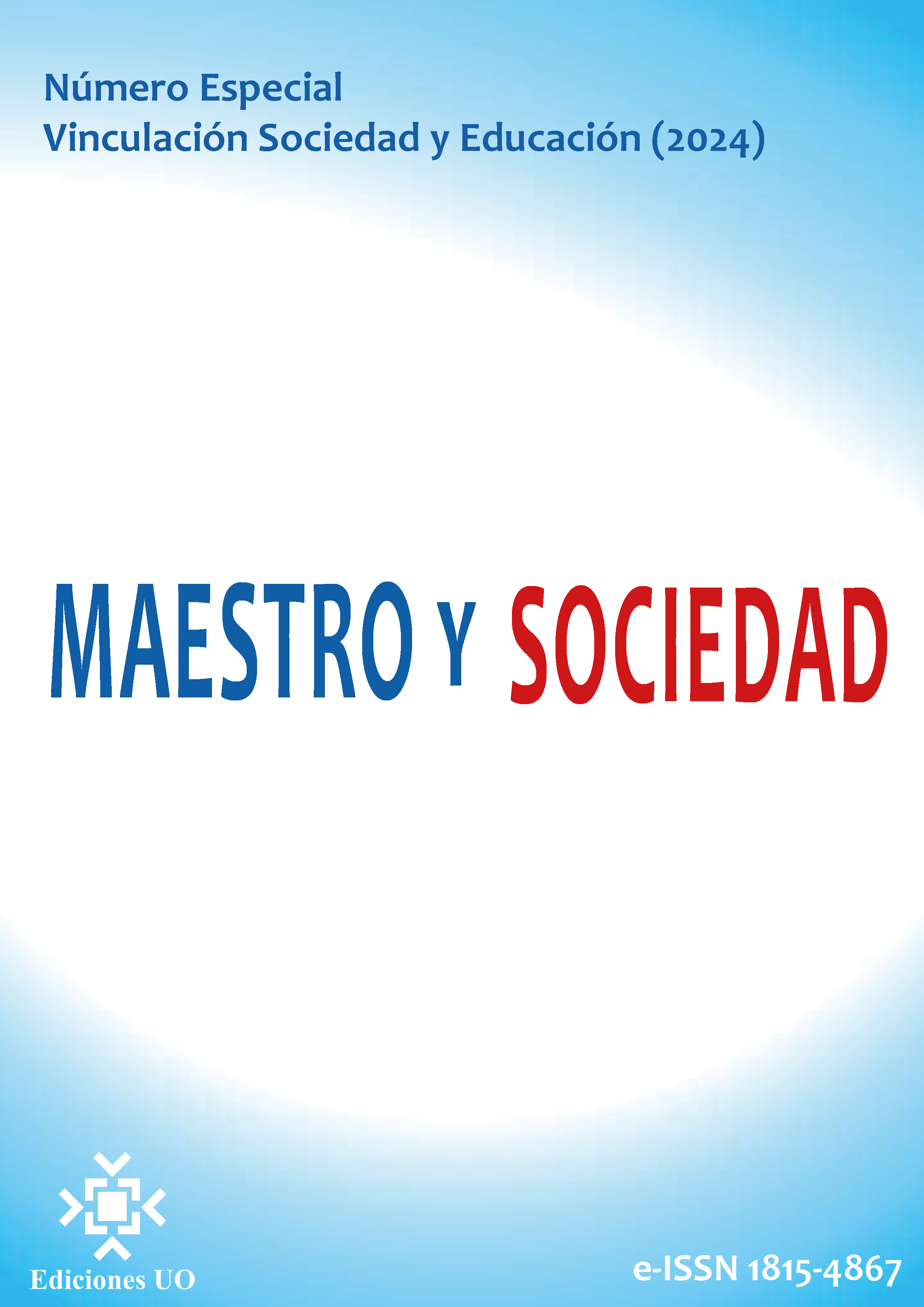The linking activity: approach to the rescue of People, Ethnicity and Culture
Keywords:
rescue of the people, ethnicity, cultureAbstract
Introduction: Ecuador works to safeguard a diverse, pluricultural and multiethnic cultural identity, which identifies it by its values, traditions, symbols, beliefs and modes of sociocultural behavior. The objective of this study is to diagnose the self-identification according to their culture and customs of Manabi residents to determine multicultural rescue strategies. Materials and methods: The population under study is the cantons of Sucre, San Vicente, Jama and Pedernales, made up entirely of 150,678 residents. Simple non-probabilistic random sampling will determine the market segment under study. The statistical software REDATAM (Data Recovery for Small Areas by Microcomputer) made it possible to develop a cross-analysis of self-identification statistical figures. The statistical software SPSS v. 26 confirmed that the statistical reliability of the results was .92 Cronbach's alpha, considered very good. Results: It is declared that the linking activity through the project "Contribution from the Montubian tradition to the socio-cultural, economic, agricultural, agricultural, food, hospital-tourist development of the Sucre - San Vicente community" with a participation of 120 students and beneficiaries 5,494 residents who represent approximately 50% of the inhabitants of San Isidro. As a corrective strategy, the community project of the community “Raíces y Sueños” in the creation of training schools for the development of family entrepreneurship Discussion: In the province of Manabí, 69.7% self-identify as mestizo and 19.2% as montubio, which are the two most representative figures at the provincial level, but at the level of the four cantons under study which are integrated into the research projects of the Bahía Extension and the department of links with society who, under their contexts, seek alternatives to strengthen tourist activity in the destination Sucre-San Vicente-Jama-Pedernales. Conclusions: The review of literature and bibliographies regarding the object and field of research made it easier to consider that it is vitally important to create a new scenario where the aboriginal cultures that still exist on the planet have a space of integration in which they settle comfortably without losing their autonomy and identity from the reality of each ethnic group, respecting their cultural, social, and religious expressions.
References
Angulo-Giraldo, Quispe-Díaz, & Requena-Calderón. (2019). Migración, autoidentificación y religión: los estudiantes de la Facultad de Letras y Ciencias Humanas (Universidad Nacional Mayor de San Marcos). Praxis, 15(2), 207-221, https://dialnet.unirioja.es/descarga/articulo/7437388.pdf.
Caicedo, M. A., Cedeño, R. E., Chica, N., Moreira, J., & Villacis, L. (2020). La gestión de recuersos para la casa montubia San Isidro. Uleam Megazine Bahia, 1(1), 77-89. https://revistas.uleam.edu.ec/index.php/uleam_bahia_magazine
Calderón, J., Ortiz, K., & Alcívar, C. (2018). Análisis factorial exploratorio como método multivariante para validación de datos académicos en plataformas virtuales. Revista Lasallista de Investigación, 15(2), 10-19. https://doi.org/https://www.redalyc.org/journal/695/69559233002/html/
EDX. (2022). Aprende identidad cultural. https://www.edx.org/es/aprende/identidad-cultural#:~:text=%C2%BFQu%C3%A9%20es%20la%20Identidad%20Cultural,genera%20un%20sentido%20de%20
Fernández, I., & Fernández, I. (2012). Aproximación Teórica a la identidad cultural. Ciencias Holguín, XVIII(4), 1-13. https://doi.org/https://www.redalyc.org/pdf/1815/181524363004.pdf
Gestión, R. (2022). Gestión Digital. El turismo en el Ecuador aún está lejos de recuperarse: https://revistagestion.ec/economia-y-finanzas-analisis/el-turismo-en-el-ecuador-aun-esta-lejos-de-recuperarse
GOB. (2022). Defensoria del Pueblo Ecuador . https://www.dpe.gob.ec/tiempo-derechos-la-identidad-cultural-derecho-intrinseco-las-personas/#:~:text=Ecuador%20tiene%20una%20identidad%20cultural,m%C3%A1s%20respetuosa%2C%20inclusiva%20y%20solidaria.
IAEN. (2022). Vinculación con la sociedad. https://www.iaen.edu.ec/la-universidad/vinculacion-con-la-sociedad/
Lemoine, F. A., Carvajal, G., Villacis, & Moncerrate, L. (2023). Responsabilidad social comunitaria en función de los procesos sustantivos: Universidad del siglo XX. Maestro y Sociedad , 20(1), 216-223. https://doi.org/https://maestroysociedad.uo.edu.cu/index.php/MyS/article/view/5911
Lemoine-Quintero, Carvajal-Zambrano, Chica-Medranda, & Espinoza-Arauz. (2022). Desarrollo metodológico del proyecto de vinculación con la sociedad: “Los Passaos Emprenden con Historia”, Ecuador. Revista maestro y Sociedad, 19(1), 365-380, https://maestroysociedad.uo.edu.cu/index.php/MyS/article/view/5505/5254.
Martínez, N. (2015). Identidad cultural y educación. REDICCES. https://doi.org/http://www.redicces.org.sv/jspui/bitstream/10972/2055/1/3.%20Identidad%20cultural%20y%20educacion.pdf
Molano, O. L. (2007). Identidad cultural un concepto que evoluciona. Opera, 7, https://www.redalyc.org/pdf/675/67500705.pdf.
Pèrez-Leòn. (2019). Coeficiente Alfa de Cronbach: ¿Qué es y para qué sirve el Alfa de Cronbach? https://gplresearch.com/coeficiente-alfa-de-cronbach/
UNAE. (2022). Vinculación con la Sociedad. https://unae.edu.ec/vinculacion-con-la-sociedad/
UNL. (2021). Vinculación con la Sociedad. https://www.unl.edu.ec/vinculacion-con-la-sociedad#:~:text=La%20vinculaci%C3%B3n%20con%20la%20sociedad,e%20investigativo%20y%20al%20cumplimiento
USFQ. (2020). Vinculación con la Sociedad . https://www.usfq.edu.ec/es/vinculacion-con-la-sociedad
UTA. (2018). PLAN DE VINCULACIÓN CON LA SOCIEDAD. Universidad Técnica de Ambato: https://fche.uta.edu.ec/v3.2/vinculacion/convenios/plan.pdf
UTE. (2022). Vinculación con la Sociedad. https://www.ute.edu.ec/vinculacion-con-la-sociedad/
Varas, R. C., Aucapiña, S. E., & Ortiz, M. R. (2018). LA IDENTIDAD CULTURAL EN LOS LÍDERES DEL FUTURO. Revista Ciencias Pedagógicas e Innovación, VI(1). https://doi.org/https://incyt.upse.edu.ec/pedagogia/revistas/index.php/rcpi/article/view/230/335
Villacis, L. M., Jácome, L. V., Lemoine, Ángel, F., & Zambrano, J. A. (2021). La nueva generación receptora de la identidad de pueblo: San Isidro – Ecuador. Centro Sur, 5(1), 81–89, https://doi.org/10.37955/cs.v5i1.101.
Villacis, L., & Delgado, Y. (2019). MITOS Y LEYENDAS COMODESAFÍO AL TURISMO DE BAHÍA DE CARÁQUEZ. Revista Magazine de las Ciencias.Publicación trimestral, 4(4), 46-55, https://revistas.utb.edu.ec/index.php/magazine/article/view/572.
Villacis, L., Castellanos, G., Lemoine, F. A., Montesdeoca, M. G., & Barberán, M. A. (2023). Pueblo, Etnia y Cultura: Un acercamiento al entorno multicultural del Ecuador. Salud, Ciencia y Tecnología - Serie de Conferencias [Internet]. 7 de mayo. https://doi.org/https://conferencias.saludcyt.ar/index.php/sctconf/article/view/177
Published
How to Cite
Issue
Section
License
Copyright (c) 2024 Lilia Moncerrate Villacis Zambrano, Frank Ángel Lemoine Quintero, Lucia Margarita Álvarez Zambrano; Elizabeth Del Carmen Ormaza Esmeraldas; Jhen Kennedy Velez Ganchozo

This work is licensed under a Creative Commons Attribution-NonCommercial-NoDerivatives 4.0 International License.
This journal provides immediate open access to its content, based on the principle that offering the public free access to research helps a greater global exchange of knowledge. Each author is responsible for the content of each of their articles.



























 Universidad de Oriente
Universidad de Oriente 